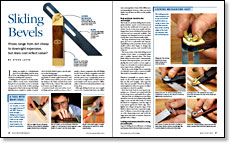Sliding Bevels
Prices range from dirt cheap to downright expensive, but does cost reflect value?
Synopsis: The sliding bevel is an essential measuring and marking tool for woodworkers, and in this article, woodworking instructor Steve Latta tests eight sliding bevels for quality and accuracy—the Craftsman 39582, Bridge City TB-6, Crown Tools, Richard Kell, Gladstone 10 1/2, Starrett 47, Shinwa 70, and Veritas 05N44.01. Find out which styles, features, and sizes are best for various tasks, and how to find a tool that fits your budget . Also find a quick reference to various tasks where a sliding bevel can come in handy.
From Fine Woodworking #170
Laying out angles is a fundamental part of woodworking, and for most of us, the sliding bevel is the tool of choice for tackling this operation.
A sliding bevel consists of a body (sometimes called a stock) and a slotted blade that pivots on a machine screw or steel pin on one end of the body. A thin opening along much of the body accepts the blade. Manufacturers employ a variety of methods to lock the blade in place.
By pivoting the blade, you can adjust it to any inside or outside angle between 0° and 180°. And because it slides, you can control the distance the blade extends from each edge of the body, a feature that makes the tool easy to use in tight spots.
A search of mail-order and online woodworking catalogs quickly produces a list of nearly a dozen companies that sell sliding bevels. Some of these companies carry just one size or style, others offer two or more, and the prices vary considerably, from as low as $5 to as high as $90. To find out how such similar tools can be priced so differently, I ordered several and put them to use in my shop.
Although sliding bevels are not complicated tools, I learned that there are differences among them. Some of the differences are immediately obvious, others are more subtle, but all have an effect on the quality of the tool.
The body of a modern sliding bevel can be made of plastic, metal, or wood. Rosewood has been the traditional wood species of choice, but in recent years maple and mahogany have been substituted because they cost less and are commonly available. One company uses laminated wood to produce a body that’s more dimensionally stable.
The large aluminum body on the Shinwa gives the tool a comfortable heft. Starrett, capitalizing on the properties of steel, went smaller rather than larger to design the most delicate, precise, and versatile body of the lot.
For the full article, download the PDF below.
Fine Woodworking Recommended Products

Veritas Precision Square

Stanley Powerlock 16-ft. tape measure

Veritas Wheel Marking Gauge






















Log in or create an account to post a comment.
Sign up Log in